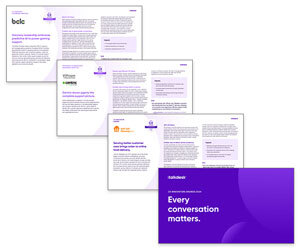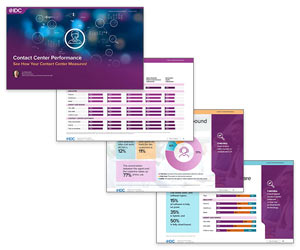Celia Cerdeira at Talkdesk dives into how AI is transforming customer service, the benefits, and how to successfully implement it across a customer experience strategy.
AI is reshaping customer service by setting a new standard for speed, personalization, and always-on support.
From tailored product recommendations to relevant content and seamless brand interactions, personalization has become the standard.
That same expectation has long applied to customer service, where people want fast, frictionless support that feels effortless and intuitive.
They expect not to repeat themselves when transferred between agents, to get help on the channels they prefer, and to have their issues resolved quickly – anytime, anywhere. Meeting these demands is what defines great customer service.
With the ability to collect and analyse customer data in real time, artificial intelligence (AI) can intelligently route requests, surface relevant information to agents, and automate routine tasks.
This means customers get faster, more efficient support-and agents can spend more time helping people instead of chasing down information or completing post-call follow-ups.
What Is AI in Customer Service?
AI in customer service refers to the use of advanced technologies – like agentic AI, machine learning, large language models (LLMs), and automation – to enhance how businesses serve their customers.
These AI tools can understand and respond to customer inquiries, anticipate needs based on past behavior, and help support teams work more efficiently.
Whether it’s a chatbot answering a simple question or a system analysing customer sentiment to escalate a conversation to a human agent, AI is designed to improve both speed and quality of service.
Most importantly, AI doesn’t replace human agents; it supports them. By automating repetitive tasks (like ticket tagging or pulling up order details), AI frees agents to focus on more complex, meaningful conversations.
It also ensures that customers are connected to the right resources faster, reducing wait times and frustration.
What Role Does AI Play in Customer Service?
AI helps companies meet rising customer expectations for fast, personalized service while reducing the burden on human agents. Check out six ways agentic AI is already enhancing customer support.
AI Generates Summaries to Reduce Post-Interaction Work
Rather than simply transcribing interactions, agentic AI actively monitors conversations and autonomously compiles concise summaries at the end of each interaction.
This reduces the need for agents to manually document details, reducing interaction handle time and improving consistency in customer records.
AI Analyses Customer Sentiment
Agentic AI proactively monitors tone, language, and behavioural cues across channels to assess customer mood instantly.
It can act on these insights immediately, such as escalating frustrated customers to a human agent or adjusting the tone of automated responses.
AI Empowers Virtual Agents With Conversational Context
AI agents actively manage conversations, drawing on context, history, and intent to make decisions. If a customer’s issue evolves, AI can pivot accordingly.
AI Promptly Responds to Customer Reviews
Instead of waiting for human intervention, agentic AI monitors review platforms, identifies new feedback, and drafts timely, relevant responses to customer reviews.
AI Powers Knowledge Bases
Agentic AI can maintain and improve knowledge bases by identifying gaps, updating outdated content, and surfacing the most relevant information during live interactions.
AI Informs Training Materials for Agents
Based on real-time performance data, agentic AI identifies where agents are struggling and proactively delivers customized training modules.
It can assign microlearning tasks, update onboarding tracks, and even simulate coaching conversations – all without needing a manager to step in.
Companies are actively exploring how to best integrate AI into their customer experience (CX) strategies, aiming to optimize workflows without compromising the personal touch that customers value.
While AI is effective at handling routine tasks, many customers still want the option to speak with a live agent when the issue is complex or sensitive.
By automating repetitive interactions, AI reduces agent workload and wait times, making it easier for teams to deliver responsive, human-to-human service where it matters most.
Benefits of AI for Customer Service
From reducing after-call work to routing customers intelligently and responding to reviews in real time, AI can automate the repetitive and optimize the complex. Below are some of the most impactful benefits AI brings to customer service operations:
- Elevate agent efficiency – By automating repetitive tasks and surfacing real-time insights, AI allows agents to spend more time solving problems and less time searching for answers.
- Improve customer satisfaction – Faster response times, more accurate solutions, and a smoother overall experience lead to higher levels of customer satisfaction and loyalty.
- Balance high demand – During spikes in support volume, AI virtual agents can reduce customer wait times.
- Empower customers with self-service options – AI-powered self-service tools like chatbots and smart FAQs help customers quickly find answers on their own – without waiting in line for a live agent.
- Enable 24/7 support availability – AI never sleeps, which means businesses can offer around-the-clock assistance to customers, no matter their time zone or schedule.
- Deliver a proactive service experience – AI can tap into contracts, warranties, purchase history, and marketing data to surface timely, relevant next steps – from subscription renewals to maintenance reminders or upgrade offers.
Examples of AI in Customer Service
Let’s explore how AI can enhance customer service regardless of industry. Here are just a few examples:
Empower Autonomous Decision-Making With AI Agents
AI agents respond to commands, observe, analyse, and act based on dynamic conditions and contextual data.
Whether deciding how to prioritize incoming support tickets, identifying when to escalate a customer issue, or selecting the most appropriate self-service content, agentic AI speeds up operations by reducing delays and human bottlenecks.
AI agents can be linked into full-scale agentic workflows that handle end-to-end tasks across the customer service journey.
For example, one AI agent might detect a drop in customer sentiment during a live chat, another could decide to escalate the conversation to a human agent, while a third drafts a follow-up email or logs a case for future reference.
These workflows can be configured to learn and improve over time, enhancing their decision-making capabilities and impact. The benefit? A customer service operation that is proactive, responsive, and highly scalable.
Forecast, Schedule and Assign Agents With AI-Powered Workforce Management
Workforce management has always been a balancing act, ensuring a business has the right number of agents, at the right time, with the right skills.
AI takes a lot of the guesswork out of that process. When it comes to forecasting, AI analyses historical trends like seasonal spikes, volume patterns, and even year-over-year changes to predict how many agents are needed to keep service levels high.
Instead of spending hours crunching numbers manually, teams can rely on AI to deliver fast, accurate forecasts that help prevent understaffing and overstaffing.
With solid forecasts in place, AI also helps build smarter schedules. It factors in agent availability, skills, contract requirements, and calendar conflicts to create shifts that work for everyone.
Then comes the trickiest part: assigning the right roles to agents. AI can evaluate each agent’s experience, strengths, and past performance to match them with the tasks best suited to their skills.
The result? A smoother operation, a more motivated team, and a customer service experience that feels thoughtful and responsive, even during the busiest times.
Strengthen Your Knowledge Base
A strong knowledge base is one of the most valuable tools in a customer service toolkit. With AI, support teams no longer need to manually sift through documentation or guess which article fits a customer’s issue.
Instead, AI delivers automated, context-relevant answers directly to agents or customers based on the inquiry’s intent, past interactions, or current context.
Tools let you publish these AI-generated answer cards instantly or author them manually when needed, with routing rules that ensure the right information reaches the right team.
AI Also Simplifies Knowledge Consolidation
With knowledge base connectors, you can unify content from various third-party platforms into a centralized system – eliminating silos and making it easier for agents (and AI systems) to find accurate, up-to-date information fast. Uploading FAQ files is just as seamless.
Improve the Efficiency, Scale, and Quality of Customer Feedback
AI transforms how companies collect, understand, and act on customer feedback – turning what was once a manual, time-consuming process into a dynamic, continuous loop. It starts with smarter survey creation.
AI can help generate personalized, context-aware survey questions based on the customer’s recent interactions, purchase history, or support journey.
It can also automate deployment across channels, ensuring surveys reach customers at the right moment for higher response rates and more relevant insights.
Plus, instead of sifting through spreadsheets or manually coding open-ended responses, AI quickly processes survey data and unstructured feedback to identify trends, pain points, and emerging opportunities.
It can surface the most critical CX metrics – like customer satisfaction score (CSAT), net promoter score (NPS), and customer effort score (CES) – and even go further by highlighting the why behind those scores through sentiment analysis and natural language processing.
Provide Real-Time Agent Assistance
What if all human agents had a knowledgeable assistant by their side during every interaction – one that could instantly surface answers, suggest next steps, and guide them through complex issues?
That’s exactly what AI-powered live assistance makes possible. Rather than pausing to search for information or escalate a case, agents can get real-time support as they’re speaking with customers.
AI listens to the conversation, understands the context, and provides timely, relevant suggestions to help agents respond quickly and accurately.
This live guidance helps reduce average handle time (AHT), increase first contact resolution (FCR), and improve agent confidence and customer satisfaction. It also ensures consistent service quality by making expert-level knowledge accessible to all agents.
How to Implement AI Across a Customer Service Environment
Bringing AI into a customer service strategy starts with building a thoughtful, scalable foundation that aligns with a business’s goals, teams, and customer expectations. Here’s a step-by-step guide to implementing AI across a customer service environment:
Define Goals
Start by identifying the key pain points or opportunities in a customer service operation.
Whether the objective is to reduce wait times, improve self-service, lower operational costs, or boost customer satisfaction clearly defined goals will guide the AI strategy and provide benchmarks for measuring success.
Assess the Current CX Infrastructure
Businesses should take stock of their existing tools, workflows, and data systems. It’s important to consider how AI can integrate with current platforms – including CRM systems, knowledge bases, and communication channels – to enhance performance without disrupting core processes.
Choose the Right AI Capabilities
Selecting the most appropriate AI tools depends on a business’s goals – whether that’s improving response times, enhancing customer satisfaction, or streamlining support operations.
Technologies like virtual agents, sentiment analysis, and knowledge management automation can help achieve those outcomes.
Start With a Pilot Program
Begin small by applying AI to a specific use case, such as automating post-call summaries. A controlled pilot can help businesses evaluate impact, gather feedback, and make adjustments before a full rollout.
Train the Team
Ensure agents, supervisors, and admins understand how AI tools work and how they’ll support their roles. Training and change management are essential to adoption and long-term success.
Monitor Performance and Feedback
Use analytics dashboards and agent/customer feedback to track performance. Keep an eye on key performance indicators (KPIs) like handle time, resolution rate, and customer satisfaction to see how AI impacts service.
Exploring the Future of AI in Customer Service
AI is redefining every aspect of customer service, transforming it from a cost centre into a strategic advantage.
With the ability to analyse sentiment, predict customer needs, and automate routine interactions, AI provides actionable insights that drive better business decisions.
While human agents remain central to delivering exceptional service, AI equips them with the tools to resolve issues faster and deliver more personalized experiences.
Companies embracing AI are already seeing significant gains in efficiency, customer satisfaction, and operational performance.
This blog post has been re-published by kind permission of Talkdesk – View the Original Article
For more information about Talkdesk - visit the Talkdesk Website
Call Centre Helper is not responsible for the content of these guest blog posts. The opinions expressed in this article are those of the author, and do not necessarily reflect those of Call Centre Helper.
Author: Talkdesk
Reviewed by: Jo Robinson
Published On: 27th May 2025
Read more about - Guest Blogs, Celia Cerdeira, Talkdesk






 Talkdesk is a global customer experience leader for customer-obsessed companies. Our contact center solution provides a better way for businesses and customers to engage with one another.
Talkdesk is a global customer experience leader for customer-obsessed companies. Our contact center solution provides a better way for businesses and customers to engage with one another. 












